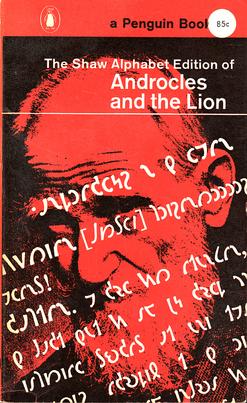
Blissymbols or Blissymbolics is a constructed language conceived as an ideographic writing system called Semantography consisting of several hundred basic symbols, each representing a concept, which can be composed together to generate new symbols that represent new concepts. Blissymbols differ from most of the world's major writing systems in that the characters do not correspond at all to the sounds of any spoken language.

The Cirth is a semi‑artificial script, based on real‑life runic alphabets, one of several scripts invented by J. R. R. Tolkien for the constructed languages he devised and used in his works. Cirth is written with a capital letter when referring to the writing system; the letters themselves can be called cirth.
ISO/IEC 8859 is a joint ISO and IEC series of standards for 8-bit character encodings. The series of standards consists of numbered parts, such as ISO/IEC 8859-1, ISO/IEC 8859-2, etc. There are 15 parts, excluding the abandoned ISO/IEC 8859-12. The ISO working group maintaining this series of standards has been disbanded.

The Shavian alphabet is an alphabet conceived as a way to provide simple, phonemic orthography for the English language to replace the difficulties of conventional spelling using the Latin alphabet. It was posthumously funded by and named after Irish playwright Bernard Shaw.
The Coptic script is the script used for writing the Coptic language, the latest stage of Egyptian. The repertoire of glyphs is based on the uncial Greek alphabet, augmented by letters borrowed from the Egyptian Demotic. It was the first alphabetic script used for the Egyptian language. There are several Coptic alphabets, as the script varies greatly among the various dialects and eras of the Coptic language.

Balti is a Tibetic language natively spoken by the ethnic Balti people in the Baltistan region of Gilgit−Baltistan, Pakistan, Nubra Valley of the Leh district and in the Kargil district of Ladakh, India. The language differs from Standard Tibetan; many sounds of Old Tibetan that were lost in Standard Tibetan are retained in the Balti language. It also has a simple pitch accent system only in multi-syllabic words while Standard Tibetan has a complex and distinct pitch system that includes tone contour.

Michael Everson is an American and Irish linguist, script encoder, typesetter, type designer and publisher. He runs a publishing company called Evertype, through which he has published over a hundred books since 2006.
The ConScript Unicode Registry is a volunteer project to coordinate the assignment of code points in the Unicode Private Use Areas (PUA) for the encoding of artificial scripts, such as those for constructed languages. It was founded by John Cowan and was maintained by him and Michael Everson. It is not affiliated with the Unicode Consortium.
In Unicode, a Private Use Area (PUA) is a range of code points that, by definition, will not be assigned characters by the Unicode Consortium. Three private use areas are defined: one in the Basic Multilingual Plane, and one each in, and nearly covering, planes 15 and 16. The code points in these areas cannot be considered as standardized characters in Unicode itself. They are intentionally left undefined so that third parties may define their own characters without conflicting with Unicode Consortium assignments. Under the Unicode Stability Policy, the Private Use Areas will remain allocated for that purpose in all future Unicode versions.

The Pollard script, also known as Pollard Miao or Miao, is an abugida loosely based on the Latin alphabet and invented by Methodist missionary Sam Pollard. Pollard invented the script for use with A-Hmao, one of several Miao languages spoken in southeast Asia. The script underwent a series of revisions until 1936, when a translation of the New Testament was published using it.
The Klingon scripts are fictional alphabetic scripts used in the Star Trek movies and television shows to write the Klingon language.

The Sorang Sompeng script is used to write Sora, a Munda language with 300,000 speakers in India. The script was created by Mangei Gomango in 1936 and is used in religious contexts.

Code2000 is a serif and pan-Unicode digital font, which includes characters and symbols from a very large range of writing systems. As of the current final version 1.171 released in 2008, Code2000 is designed and implemented by James Kass to include as much of the Unicode 5.2 standard as practical, and to support OpenType digital typography features. Code2000 supports the Basic Multilingual Plane. Code2001 was a designed to support the Supplementary Multilingual Plane, with ISO 8859-1 characters shared with Code2000 for compatibility. A third font, Code2002, was left substantially unfinished and never officially released.
The ISO basic Latin alphabet is an international standard for a Latin-script alphabet that consists of two sets of 26 letters, codified in various national and international standards and used widely in international communication. They are the same letters that comprise the current English alphabet. Since medieval times, they are also the same letters of the modern Latin alphabet. The order is also important for sorting words into alphabetical order.
Runic is a Unicode block containing runic characters. It was introduced in Unicode 3.0 (1999), with eight additional characters introduced in Unicode 7.0 (2014). The original encoding of runes in UCS was based on the recommendations of the "ISO Runes Project" submitted in 1997.
Bassa Vah is a Unicode block containing characters of the Bassa Vah alphabet which were historically used for writing the Bassa language of Liberia and Sierra Leone.
ISO 5426 is a character set developed by ISO, similar to ISO/IEC 6937. It was first published in 1983.

The Tai Viet script is a Brahmic script used by the Tai Dam people and various other Thai people in Vietnam and Thailand.
Tolkien's scripts are the writing systems invented by the philologist and fantasy author J. R. R. Tolkien. The best-known are Cirth, Sarati, and Tengwar.










